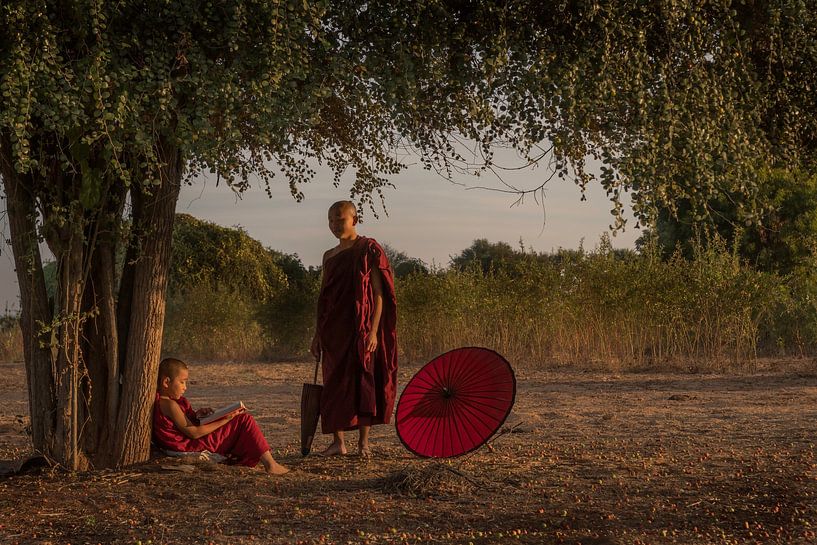Buy the photo Socialising under a tree between two young monks by Anges van der Logt on canvas, ArtFrame, poster and wallpaper, printed on demand in high quality.
About "Socialising under a tree between two young monks"
by Anges van der Logt
About the artwork
The city of Pagan (also called Bagan) is one of Myanmar's former capitals, and was founded in the year 849. It was the capital of the Pagan Empire, where Theravada Buddhism was the main faith. This can be seen from the huge number of temples still standing in Pagan today; Pagan has the largest collection of Buddhist temples, ruins and stupas in the world. In 1287, the city was abandoned by its residents, who left the city in fear as the Mongols were coming to conquer it. Perhaps partly because the city was deserted when the Mongols arrived, little damage was done to the city itself by the Mongols. Thousands of temples still stand today, often in relatively good condition. An earthquake in 1975 damaged many of the temples, which could not always be repaired. Pagan is one of the major tourist destinations in Myanmar, and has been on the Unesco World Heritage List since July 2019. Today, Pagan is a small town of 20,000 people and there are many hotels around Pagan, where tourists stay. Pagan is much less known than the temples of Angkor Wat in Cambodia. The reason for this is the restictive policy towards tourists and internationalisation that Myanmar has had for a long time and still follows (to a lesser extent). For Theravada Buddhists, Pagan is also a place of pilgrimage.

About Anges van der Logt
A dutch photographer living in Jakarta, Indonesia since 1995. Specialized in landscapes and culture, mainly of Indonesia but also from other countries in Asia and elsewhere.
For examples you can have a look at my Instagram accounts: @angesvdl and @angesvdl.world..
Read more…
 Netherlands
Netherlands Ordered in March 2020
Ordered in March 2020
 Germany
Germany Ordered in March 2019
Ordered in March 2019
 Netherlands
Netherlands Ordered in September 2017
Ordered in September 2017

 Germany
Germany Ordered in July 2021
Ordered in July 2021
 Germany
Germany Ordered in May 2021
Ordered in May 2021
 Netherlands
Netherlands Ordered in March 2019
Ordered in March 2019

 Germany
Germany Ordered in August 2023
Ordered in August 2023
 Germany
Germany Ordered in March 2022
Ordered in March 2022
 Netherlands
Netherlands Ordered in October 2017
Ordered in October 2017

 Netherlands
Netherlands Ordered in June 2018
Ordered in June 2018
 Netherlands
Netherlands Ordered in November 2019
Ordered in November 2019
 Netherlands
Netherlands Ordered in May 2021
Ordered in May 2021
About the material
ArtFrame™
Interchangeable Art Prints
- High-quality print
- Easily interchangeable
- Acoustic function
- Large sizes available
Discover the artworks of Anges van der Logt
 The gamelan maestro Ki Suripto on his gamelan in Salatiga, Central Java, IndonesiaAnges van der Logt
The gamelan maestro Ki Suripto on his gamelan in Salatiga, Central Java, IndonesiaAnges van der Logt Old balinese woman with her spinning wheel in a small village near Ubud, Bali.Anges van der Logt
Old balinese woman with her spinning wheel in a small village near Ubud, Bali.Anges van der Logt Old Balinese woman in a small village near Ubud, Bali.Anges van der Logt
Old Balinese woman in a small village near Ubud, Bali.Anges van der Logt The Torii gates of Tara that lead you into the oceanAnges van der Logt
The Torii gates of Tara that lead you into the oceanAnges van der Logt The Koppelpoort in Amersfoort on a rainy dayAnges van der Logt
The Koppelpoort in Amersfoort on a rainy dayAnges van der Logt Javanese boy with his carrier pigeonsAnges van der Logt
Javanese boy with his carrier pigeonsAnges van der Logt Help in the kitchenAnges van der Logt
Help in the kitchenAnges van der Logt Sorting rice in the traditional wayAnges van der Logt
Sorting rice in the traditional wayAnges van der Logt I'm waiting for youAnges van der Logt
I'm waiting for youAnges van der Logt The potterAnges van der Logt
The potterAnges van der Logt A young monkAnges van der Logt
A young monkAnges van der Logt Reading a book in the window frameAnges van der Logt
Reading a book in the window frameAnges van der Logt Bike in the fogAnges van der Logt
Bike in the fogAnges van der Logt Fishing in the early morningAnges van der Logt
Fishing in the early morningAnges van der Logt A flock of Oystercatchers on the beach near Paesens/ModdergatAnges van der Logt
A flock of Oystercatchers on the beach near Paesens/ModdergatAnges van der Logt Borobudur in the morning mist (vertical)Anges van der Logt
Borobudur in the morning mist (vertical)Anges van der Logt Borobudur temple during sunriseAnges van der Logt
Borobudur temple during sunriseAnges van der Logt Batik in the barnAnges van der Logt
Batik in the barnAnges van der Logt Two Javanese men in an arm fightAnges van der Logt
Two Javanese men in an arm fightAnges van der Logt The arm fight in Central JavaAnges van der Logt
The arm fight in Central JavaAnges van der Logt













 Asia
Asia Photo wallpaper
Photo wallpaper Photography
Photography Serene Peace
Serene Peace Sunset
Sunset Trees
Trees Umbrellas
Umbrellas









